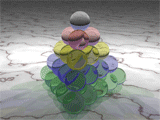Draft:Truncated Triangular Pyramid Number - Wikipedia
 | Review waiting, please be patient.
This may take 2 months or more, since drafts are reviewed in no specific order. There are 1,308 pending submissions waiting for review.
|
Submission declined on 26 September 2024 by KylieTastic (talk).
Declined by KylieTastic 8 days ago. Last edited by KylieTastic 30 hours ago. Reviewer: Inform author. This draft has been resubmitted and is currently awaiting re-review. |  |

Truncated Triangular Pyramid Number[1] are achieved by removing (truncating) some smaller Tetrahedral number (or triangular pyramidal number) from each of the vertices of a bigger Tetrahedral number (or triangular pyramidal number).
A truncated pyramid is made when cut by a plane parallel to the base and the apical part is removed. The smaller truncated sections that are removed will always be similar to the larger, original shape.
The number to be removed (truncated) may be same or different from each of the vertices - but all numbers being removed would be a smaller Tetrahedral number (or triangular pyramidal number) by itself.
A truncated number is not the same as the volume or area of the truncated shape.
Instead numbers relate more to the problem of how densely given solid objects can pack in space.[2] Dense packing of convex objects is related to problems like the arrangement of molecules in condensed states of matter[3] and to the best way to transmit encoded messages over a noisy channel.[4] Kepler's conjecture, which postulated that the densest packings of congruent spheres in 3-dimensional space have packing density (fraction of space covered by the spheres) = pi / sqrt 18 = 74.048% was proved by variants of the face-centered cubic (FCC) lattice packing.[5]
It is hypothesised that a regular tetrahedron might possibly be the convex body having the smallest possible packing density.[2] In contrast to this, the densest known packing of truncated tetrahedra can have an exceptionally high packing fraction φ = 207/208 = 0.995192..., which is almost close to unity and strongly implies its optimality.[6]
Tetrahedral Number 20 (sequence A000292 in the OEIS) yields Truncated Triangular Pyramid Number 7 (sequence A051937 in the OEIS) by truncating Tetrahedral number (or triangular pyramidal number) 4,4,4 and 1 from its vertices
Tetrahedral Number 35 (sequence A000292 in the OEIS) yields Truncated Triangular Pyramid Number 19 (sequence A051937 in the OEIS) by truncating Tetrahedral number (or triangular pyramidal number) 4 from each of the vertices
Tetrahedral Number 286 (sequence A000292 in the OEIS) yields Truncated Triangular Pyramid Number 273 (sequence A051937 in the OEIS) by truncating Tetrahedral number (or triangular pyramidal number) 4,4,4 and 1 from its vertices
Tetrahedral Number 560 (sequence A000292 in the OEIS) also yields Truncated Triangular Pyramid Number 273 (sequence A051937 in the OEIS) by truncating Tetrahedral number (or triangular pyramidal number) 84,84,84 and 35 from its vertices
Tetrahedral Number 816 (sequence A000292 in the OEIS) yields Truncated Triangular Pyramid Number 689 (sequence A051937 in the OEIS) by truncating Tetrahedral number (or triangular pyramidal number) 56,35,35 and 1 from its vertices
Tetrahedral Number 969 (sequence A000292 in the OEIS) yields Truncated Triangular Pyramid Number 833 (sequence A051937 in the OEIS) by truncating Tetrahedral number (or triangular pyramidal number) 56,35,35 and 10 from its vertices
Certain Truncated Triangular Pyramid Numbers may possess other characteristics too, like:
273 (number) is also a sphenic number and an idoneal number
204 (number) is also a square pyramidal number and a nonagonal number
- ^ Sloane, N. J. A. (ed.). "Sequence A051937 (Truncated triangular pyramid numbers))". The On-Line Encyclopedia of Integer Sequences. OEIS Foundation.
- ^ a b Conway, J. H.; Torquato, S. (2006). "Packing, tiling, and covering with tetrahedra". Proceedings of the National Academy of Sciences. 103 (28): 10612–10617. Bibcode:2006PNAS..10310612C. doi:10.1073/pnas.0601389103. PMC 1502280. PMID 16818891.
- ^ Torquato, S. (2002) Random Heterogeneous Materials: Microstructure and MacroscopicProperties (Springer, New York)
- ^ Conway, J. H. & Sloane, N. J. A. (1998) Sphere Packings, Lattices and Groups (Springer, NewYork)
- ^ Hales, T. C. (2005) Ann. Math. 162, 1065–1185
- ^ https://pubs.aip.org/aip/jcp/article/135/15/151101/190281/Communication-A-packing-of-truncated-tetrahedra
- ^ Chen, Sihai; Carroll, David L. (2002). "Synthesis and Characterization of Truncated Triangular Silver Nanoplates". Nano Letters. 2 (9): 1003–1007. Bibcode:2002NanoL...2.1003C. doi:10.1021/nl025674h.
- ^ Ishikawa, Shigeru; Nemoto, Tetsushi; Yamabe, Tokio (2018). "Theoretical study of hydrogen storage in a truncated triangular pyramid molecule consisting of pyridine and benzene rings bridged by vinylene groups". Applied Physics A. 124 (6): 418. Bibcode:2018ApPhA.124..418I. doi:10.1007/s00339-018-1841-9.
- ^ Haji-Akbari, Amir; Chen, Elizabeth R.; Engel, Michael; Glotzer, Sharon C. (2013). "Packing and self-assembly of truncated triangular bipyramids". Physical Review E. 88 (1): 012127. arXiv:1304.3147. Bibcode:2013PhRvE..88a2127H. doi:10.1103/PhysRevE.88.012127. PMID 23944434.